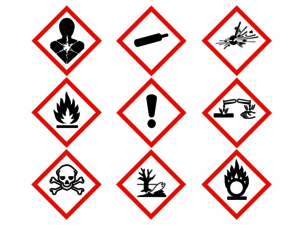The GHS is Coming in January – Are Your Chemical Labels Compliant?
The 'GHS' is the Globally Harmonised System of Classification and Labelling of Chemicals which was created by the United Nations to provide a worldwide methodology for chemical classification, labelling and safety data sheets to be used by all chemical manufacturers.
Australia began the transition to GHS under the model of Work Health and Safety Regulations in 2012. See www.safeworkaustralia.gov.au/safety-topic/hazards/chemicals/labelling-hazardous-chemicals
These changes affect the labels on the chemical containers themselves as well as the safety data sheets for those chemicals. The GHS uses 9 pictograms to identify each class of chemical and represent the physical, health-related and environmental hazards posed by each product. GHS also uses the signal words 'Danger' and 'Warning' to indicate the relative level of severity of the hazard. For more information, visit - www.safeworkaustralia.gov.au/safety-topic/hazards/chemicals/labelling-hazardous-chemicals.

Codes of Practice for Labelling
Safe Work Australia’s Code of Practice for Labelling of Workplace Hazardous Chemicals provides detailed guidance on how to label workplace chemicals. This code of practice should be used where the chemical has been classified according to the GHS.
Chemical container labels and stickers have to be instructive, providing specific information about how to safely use the chemicals (general instructions, precautions, storage and disposal directions). It is essential that the information on these sticker labels remains readable despite the harsh conditions they are exposed to.
The Globally Harmonized System of Classification and Labelling of Chemicals (GHS) is now in place in Australia, so chemical manufacturing companies need to make sure their labels are following the GHS standards. All chemical labels must follow the new GHS guidelines by January 1st 2017.
What companies are affected by the GHS?
Manufacturers, importers and suppliers of hazardous chemicals will be the most affected by the introduction of the GHS. The model work health and safety laws impose a duty on manufacturers and importers of chemicals supplied to a workplace to determine if a chemical is hazardous, and to correctly classify the chemical according to the GHS. Manufacturers and importers are also responsible for ensuring that correct GHS labels and SDS are prepared for hazardous chemicals.
End users of hazardous chemicals will be affected to a lesser extent. Users of hazardous chemicals are not required to relabel or dispose of existing stock. From 1 January 2017 onwards, suppliers and end users of hazardous chemicals must only supply and accept hazardous chemicals which have been classified and labelled in accordance with the GHS.
What States are affected by the GHS?
Victoria, Western Australia and the Australian Capital Territory have not yet mandated use of the GHS, but do require chemical hazards to be communicated. Commonwealth government agencies and licensees must also comply with the model work health and safety laws.
What chemicals are covered by the GHS?
Safe Work Australia maintains the Hazardous Chemical Information System (HCIS) database. This database contains a list of hazardous chemicals classified in accordance with the Globally Harmonized System of Classification and Labelling of Chemicals (GHS). HCIS contains GHS classifications and labelling information for over 4,500 chemicals and a searchable database of workplace exposure standards.
How are SDS affected by GHS?
Safety Data Sheets (SDS) – The format, and most of the information contained in an SDS, will remain the same as that included previously in a material safety data sheet. Importantly, information under section 2 (hazard identification) of a SDS will change: instead of displaying risk phrases (R22, R34, etc.) and safety phrases (S22, S34, etc), this section will now contain GHS hazard categories and hazard and precautionary statements. More information on the requirements for section 2 of the SDS can be found on page 11 of the model Code of Practice for the Preparation of Safety Data Sheets for Hazardous Chemicals
www.safeworkaustralia.gov.au/safety-topic/hazards/chemicals
Contact Label Power today to get a quote or speak with a label specialist about your organisation’s GHS labelling requirements or visit our website to learn more about the GHS.

